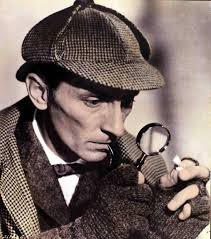 We all know about the nerds who post online corrections to errors or omissions in books, films, dramatisations and the like. Well back in 1987 , before the Internet made it all too easy, there were people like R. Lujer, who typed their complaints to—in this case—the publisher of Peter Haining’s The Television Sherlock Holmes. Haining, who was doubtless royally entertained by this particular letter, kept it in his Archive. Here it is in full.
We all know about the nerds who post online corrections to errors or omissions in books, films, dramatisations and the like. Well back in 1987 , before the Internet made it all too easy, there were people like R. Lujer, who typed their complaints to—in this case—the publisher of Peter Haining’s The Television Sherlock Holmes. Haining, who was doubtless royally entertained by this particular letter, kept it in his Archive. Here it is in full.
Dear Mr Haining,
I received a copy of your book last Christmas and have thoroughly enjoyed dipping into it before embarking upon a more orthodox read, until I reached page 179 and “The Mystery of Watson’s Dog”. I remember the review by Nancy Banks Smith and thought at the time that she had resurrected a non-event. The real mystery is the TRAIN, not the dog.
Bulldogs experience, as a rule, shortish lives, the result of overweight front ends and convolutory respiratory passages. Trains, or more exactly steam locomotives, generally had working lives of 50 or more years. Even some of the G.W.R. “Bulldog” class of 1901, transformed into “Earls” in the 1930s, were still running in the 1960s. Surely Watson’s dog simply died an early, natural death; and he found it convenient or prudent (or both) not to secure a replacement.But what of the locomotive in “The Copper Beeches”?
If my memory is correct, the house was situated near Winchester, and as Holmes and Watson needed to make a dramatic dash from London to rescue Violet Hunter, one would expect them to journey by a London & South Western Railway express from Waterloo. Imagine my surprise at the brief appearance of a 6 coupled goods engine! Admittedly, it was only shown in silhouette, so that number and Company monogram were invisible, but it looked remarkably like the 4F Class designed for the L.M.S in 1924. Only three of these locos still exist—at the Midland Railway Centre, Butterly, at the Mid-Hants Railway, Arlesford and at the North Staffordshire Railway, Cheddleton. I can only guess that the engine in question came from the third of these, when a genuine LSWR express engine (T9 Class dating from 1899 ) was resident at Arlesford.
Moving to the coloured illustrations between pages 128 and 129, I am faced with a second problem.Would Holmes have taken up residence in a house with such third rate brickwork? Or would a bricklayer really want to cut bricks as thin as that in order to insert the stone sill and then omit the bed joint? Would he then construct the lefthand reveal with quarter batts and the righthand with three quarter batts and not a queen closer in sight? I was about to suggest that Holmes should move, but my magnifying glass reveals that all of the properties in Baker Street are afflicted with similar defects—with the exception of a warehouse—so perhaps a change of channel is called for.
Yours faithfully,
R.Lujer.
When he forwarded this letter to Haining an editor at W.H.Allen remarked on a slip pinned to the letter, ‘If you will write these books for nut cases…’
Incidentally, the nerd in question was not so nerdish as to get everything right himself. Both Butterley (Derbyshire) and Alresford (Hants) are incorrectly spelt. [R.M.Healey.]

“Nerd” seems far too wimpy a word to describe any Sherlockian, let alone a Sherlockian train spotter.
Just my opinion, respectfully, not a correction.
Many thanks Lucian – hard to think of an alternative, but will put on thinking cap (geek, herbert, pedant, higher scientist, maven, wock, jock, fiend, savant…) N
How about an anorak? After all you headline with ‘train spotter’. Just saying!